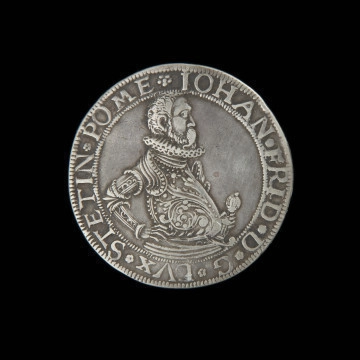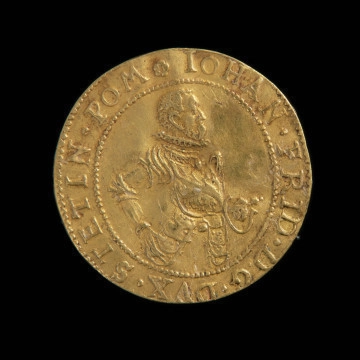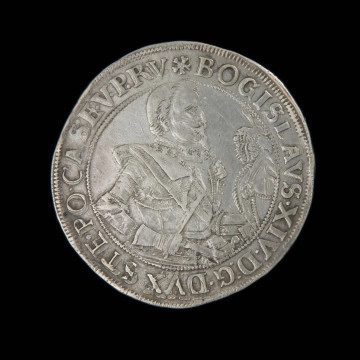
1/2 thaler
1594
National Museum in Szczecin
Part of the collections: Treasures of coins from Western Pomerania, Pomeranian coins
Ducal minting in Western Pomerania did not develop until the second half of the 12th century, after a relatively long period of using foreign coins - Arab dirhams, West European and Polish denarii and their local imitations. Around 1170 two Dukes, Bogislaw and Casimir created a unified monetary system based on the denarius, which they minted in capital and economic centres. Coins from this early period form a relatively compact and distinctive group, dating from ca. 1170 to ca. 1191. From the iconographic point of view, all of them contain demonstrative content, while some refer to contemporary political events. Denarii with the image of the ruler are highly representative and very rare. The obverse shows a half-figure of the Duke in armour, with a sword and pennant on his shoulders. The inscription on the rim states that the issuer of the coin is BOGVZLAVS (Bogislav). The reverse depicts the half-figure of Saint Sabin in pontifical attire, with a pastoral and a Roman pall on her shoulders. The prominently displayed pallium (symbol of metropolitan dignity) manifested the independence of the Pomeranian Bishopric, claimed by the bishops of Magdeburg and Gniezno. The book (most probably the Bible) was to emphasise the missionary role of the Saint. The composition and modelling of the head were influenced by Byzantine art. The cult of St. Sabin was connected to the church in Przęcław, the only church in Pomerania that bore such a name. The Saint was probably also the patron saint of the monastery on Usedom and the Pomeranian Bishopric during the temporary residence of Bishop Conrad in this monastery (c. 1170 - c. 1176/1177). Bogislaw I used the cult of the Saint as a patron of the monastery, the bishopric and the whole state in his minting policy. Undoubtedly, significant in this situation was the possession of St. Sabin's relics and the predestination of this martyr to fight against paganism. Apart from several accounts of the functioning of a monastery and bishopric on Usedom, the denarii are only material evidence of the cult of this patron. The denarii in question belong to the oldest Pomeranian issues, dating from around 1170 to 1176, and were probably minted on Usedom (part of Bogislaw I's district) when the territorial scope of the Pomeranian bishops' rule was established.
Genowefa Horoszko
Author / creator
Dimensions
cały obiekt: height: 0.7 mm, diameter: 19.2 mm
Object type
coin
Technique
minting
Material
silver
Creation time / dating
Creation / finding place
Owner
National Museum in Szczecin
Identification number
Location / status

1594
National Museum in Szczecin

1594
National Museum in Szczecin

1629
National Museum in Szczecin
DISCOVER this TOPIC
Museum of King Jan III's Palace at Wilanów
DISCOVER this PATH
Educational path